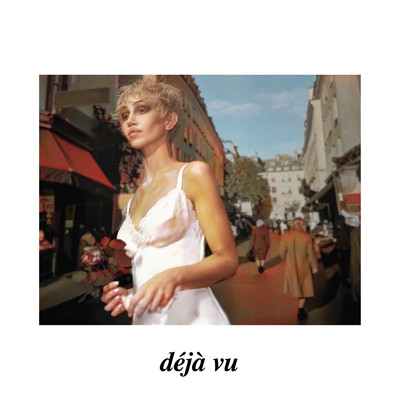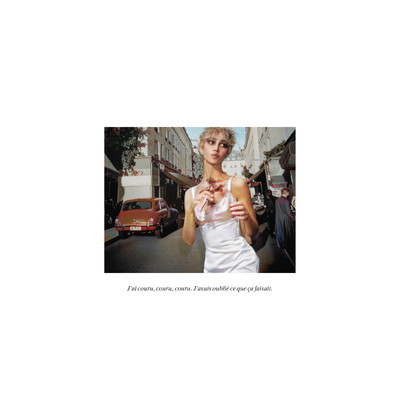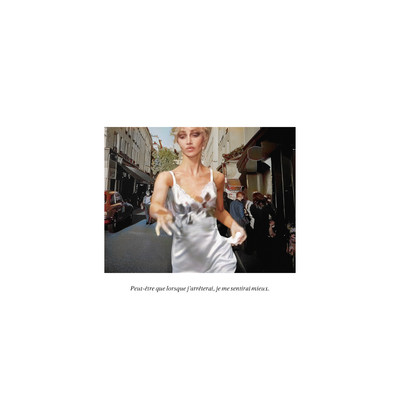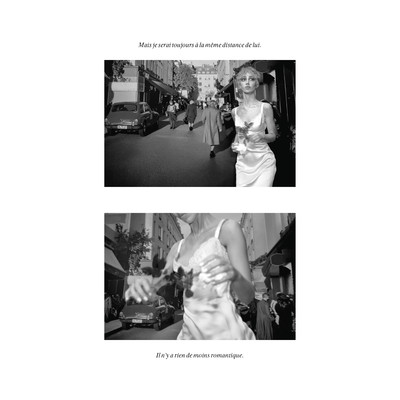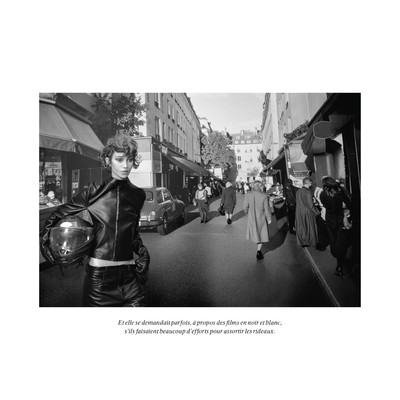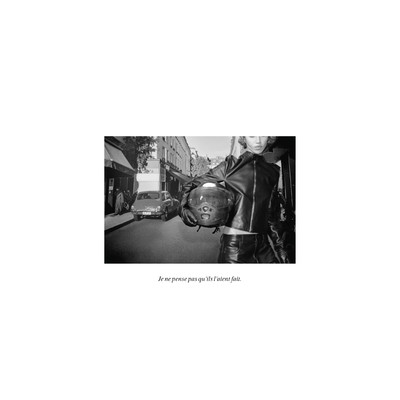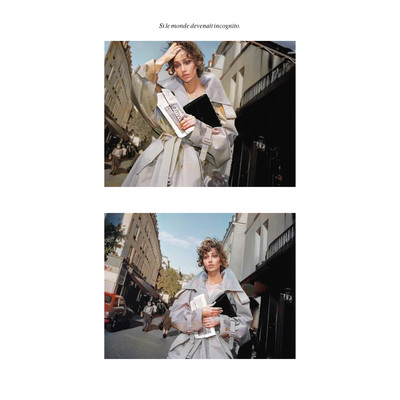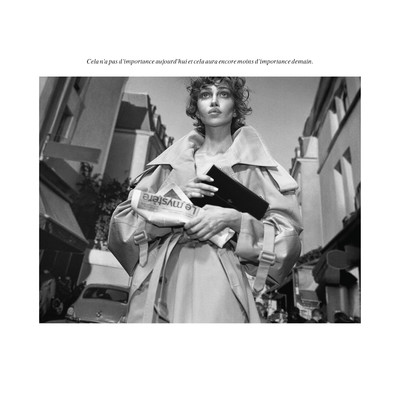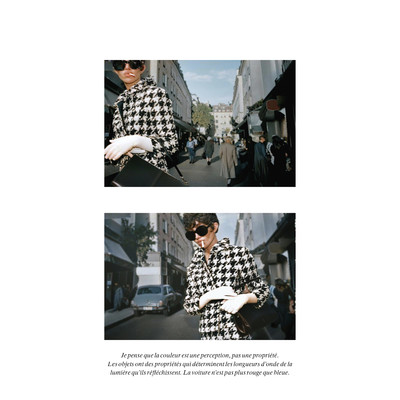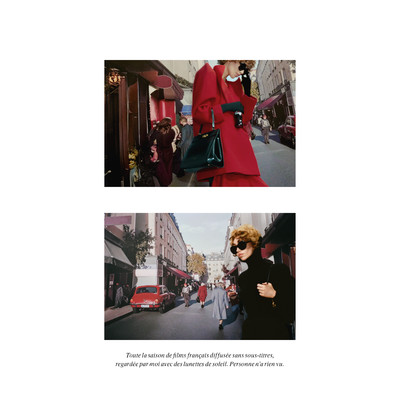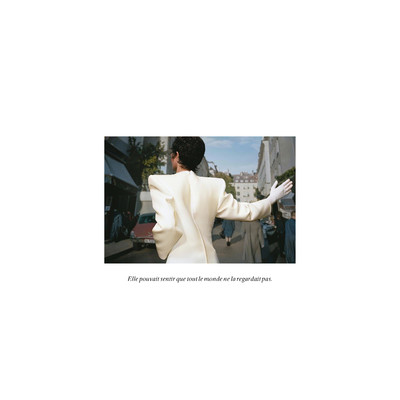Interview by David Owen
Photographs by Nadia Lee Cohen
‘Transformation requires bravery, and is usually in response to something. When someone cuts off their hair or a teenager starts dressing like a goth, it’s some sort of rebellion or fuck you to something, and I like that. Britney’s 2007, Natalie Portman’s shaved head or Angelina Jolie’s Billy Bob era. It’s making a statement and, I guess, does the same thing for me as those Essex mums on my first day of school – the bleached blowouts, big boobs and immaculate morning make-up getting out of shiny Audi A3s.’
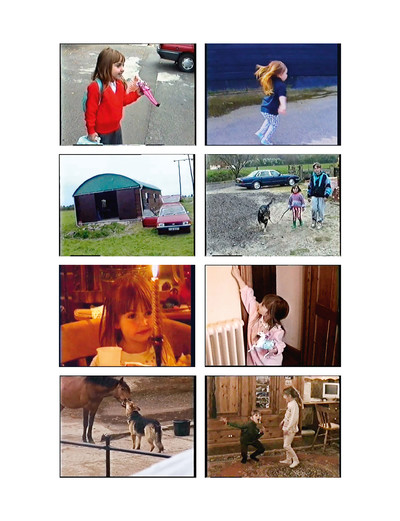
Video stills from the early life of Nadia Lee Cohen.
It has been six years since IDEA published Nadia Lee Cohen’s Women, a book that had taken her six years to make. Track back those six plus six years and Nadia would still be at London College of Fashion. Hers is a short story but a vivid one, like how the biggest action movies have the shortest screenplays. A lot of work has been made in what seems like an ever decreasing amount of time. In the last six months, Nadia has released the Julie Bullard book with Martin Parr, shot Zendaya into space for On, paired Kate Moss with Ray Winstone for Perfect, appeared as a giant woman in giant ads for Instagram, photographed and filmed Kyle MacLachlan for Balenciaga, Kim Kardashian for Skims (again), and made and released her own music video for Aphex Twin. And that will only be some of it.
IDEA got lucky with Women; it was expensive to print and Nadia wanted it big and gold and looking more like a major monograph than a first photobook. We had three other hit books that Christmas in 2019 that had all sold out within a week or two of release. Women went quietly on sale one Thursday afternoon, backed by a feature on anothermag.com, and sold maybe 20 copies by 5pm. Then Nadia woke up in LA and posted it on her Instagram and… Our office phone makes a ‘kerching’ sound when a book sells and it rattled away like a Gatling gun. I stayed up until around 3am. All thousand copies of that first edition were sold by 9am the next morning. Angela, my wife and partner in IDEA, bought Nadia a jewellery box from Asprey for Christmas.
In the years that have followed that first release, IDEA has been at pains to keep up with her. We published her second book, HELLO My Name Is…, built a cinema in Dover Street Market London, and produced a Japanese pirate version of Women as an excuse to take ourselves to Tokyo. The one thing we respond to most of all is talent – and Nadia has a lot of it. She also likes to use it and is generous with it too. We have become close collaborators. I write scripts for her commercials and film projects; Dominik Pollin and Karla Järvinen, who work for IDEA, design her books and zines and even props for her film shoots. We all like making things, and no one more so than Nadia. Everyone who works with the company has worked with her in some capacity and is a friend. Right now, courtesy of the Julie Bullard installation, we have a Hollywood special-effects level, full-size waxwork of her in a coffin in our office kitchen. At IDEA, there is literally no getting away from her.
David Owen: Bear in mind that everything you say now is going to be recorded, appear in print, remain on the internet forever and could be used as evidence against you.
Nadia Lee Cohen: Do not speak freely, basically.
Best not to include the barbecue chess story you just told me.
Right. Well, I am going to speak freely, and then we’ll chop it up.
Let’s start early in the story. When did you first get an idea that you were going to be a creative person and an artist?
I don’t know if I knew that was even a thing. I think I just did kid stuff that I wanted to do, what all kids do. During my primary school years, my brother and I would spend a lot of time in the fields surrounding the derelict farm in Essex that dad was trying to make into our house. I’d be outside all day getting covered in dust, mud and pond water. Very boyish. No hairbrushes, no dresses. Just roaming around on this little quad bike. Then I’d come in and sit in front of the TV, quite self-sufficient. I’d make a little cheese sandwich with a packet of crisps and a bit of orange juice and sit cross-legged in front of the TV binging Cartoon Network. Stuff like Johnny Bravo, The Flintstones, Tom and Jerry and then, at 6pm on a Tuesday I’d watch Ren and Stimpy with my brother, that was my favourite. I think all that is the basis of why I like what I like now, it is purely the contrast between cartoonish bright colour and the rural British palette of browns and green. Escapism was as basic as looking at the TV… In colour. There was a period where I would continually draw cartoons. The reason this is at all notable is because one era consisted of sketches of women with different coloured hair and really big boobs – a huge Crime and Punishment sized ring-binder full of them. I think I probably got the inspiration from playing Tomb Raider; Lara Croft had quite big ones. But the reason I’m saying this is because it was a prelude of what was to come and what I would eventually find myself interested in.
‘I remember watching a girl at school with very long, blonde curly hair smear pink lip gloss over the edges of her mouth, with a Lancôme Juicy Tube.’
This is all inspired by the TV and games. When did it become real?
On my first day of high school, I remember getting ready in a mid-calf-length skirt, Clarks shoes that came with a free watch, two Princess Leia buns on each side of my head, and unplucked eyebrows that were dangerously close together in the middle. We drove to my school on the outskirts of London and pulled up in dad’s shit estate car. A fleet of shiny BMWs, Mercedeses and Audi A3s were all lined up next to each other and the next scene still plays in my head now in slow motion. The mums getting out of their cars, revealing bleached blowouts, big boobs and immaculate morning make-up. I’d never… I hadn’t seen that many people with blonde hair in such close proximity. My mum doesn’t wear make-up, so this was one of the first things I noticed and was interested in. And then there were the daughters, who were mini versions of the mums. I remember watching one girl with very long, blonde curly hair get out; she smeared pink lip gloss over the edges of her 13-year-old mouth with a Lancôme Juicy Tube. I was like, ‘Wow, this is it, this is glamour.’ I didn’t understand yet what ‘transformation’ was, and that it was even an option to have hair a different shade to what you were born with. I remember the heat of embarrassment rising up because I didn’t fit the aesthetic and it wasn’t something I was familiar with feeling. Up until that very moment it just hadn’t mattered, and then immediately, with a gut punch, it mattered more than anything and I had to work on blending in. After that first week, I did some deep-dive research into pioneers of ‘the Essex look’ via magazines like Heat, Sugar and Bliss; people like Jordan [Katie Price], Jodie Marsh, Paris Hilton and Nicole Richie. I think even Donatella was inspo. It didn’t take long to realise I needed basic essentials: tan and bleach. I got a Saturday job in a local hair salon, 20 quid a week for sweeping up, washing hair and making cups of tea. This funded the tan – which was a tenner – and the girls at the salon would bleach my hair whenever my dark roots came through. So, I think, by way of that long, long story, that was where I first noticed I was interested in ‘character’ of any kind.
And what about you becoming a photographer, an artist?
See, now this is a shit story. It was literally that my friend in college was studying photography. She asked if I would model for her and took some pictures of me wearing some not-great outfits that another girl studying dressmaking had made. This dressmaker told me she was going on to London College of Fashion and that she was doing the ‘Fashion Portfolio’ course. She explained it was where you do a little bit of everything until you figure out what you’re good at. As I didn’t know what I wanted to do in general, this strategy sounded good to me. So that’s what I did. I was quickly able to eliminate textiles, design and marketing from my various options, as I was terrible at all of them. Styling and photography were all that remained for me. One day the tutor said: ‘You need to pick one because you can’t do both,’ so I picked photography and that was that. I still do not think that I’m a photographer. Didn’t then and don’t now.
And after LCF, did you just start working? You didn’t spend years waitressing or driving a taxi, waiting for your chance?
Well, I’d served my time at the hair salon and I knew I wanted to go to America. The reason being, when I made the decision to pursue photography, I went into the university library and sat on the floor with a pile of books that looked interesting. From what I can remember, these were Larry Sultan, William Eggleston, Philip-Lorca DiCorcia, Nan Goldin and Martin Parr. I was drawn to the use of colour and the shared theatrical spotlight cast onto objects and subject matter that I’d previously not paid any attention to. Martin’s work stood out because he was doing what they were doing, but the main difference was that his photos were funny. I loved that combination, and remember the revelation that it was possible to make a strong, unsettling statement and be funny without having to utter a word. From that point, I wanted to visit the environment of the American photographers but look at it with an eye like Martin’s.
My photography tutor told me about a grant that no one had applied for. It was five grand to do whatever you wanted with. Which, at the time, was a total dream. I applied and won purely on the percentage basis that I was the only applicant. I bought myself and my friend a ticket to LA and spent eight weeks there taking pictures and getting into and out of trouble. We bought a BMW for $700. Only it wasn’t actually a BMW, it was a Nissan, with the shell of a BMW on top of it. For some reason, someone had done that.
That’s so cool, but what would be even better is if it was just actually a Nissan, and they’d stuck the badges on it.
That would be way better, yes, like a Rolls-Royce fairy. Much cooler. What’s funny though, the photos from that trip became Women, the book we first did together. That was where it started.
And your fascination with transformation was always there?
Yes. Somebody asked me the other day if I would shoot a singer. And this singer hasn’t changed their appearance, like, ever. Same hair, same glam, same styling. And I was thinking, ‘Why do I not feel inspired by this person?’ And I think that what it boils down to is that change usually requires bravery and is in response to something. When someone cuts off their hair or a teenager starts dressing like a goth, it’s some sort of rebellion or fuck you to something, and I like that. Britney’s 2007, Natalie Portman’s shaved head or Angelina Jolie’s Billy Bob era. It’s making a statement and, I guess, does the same thing for me as when I saw the Essex mums. I like being able to see ‘eras’ in a person physically or in their art. I think this is true of myself too. I’m in the era of teenage-boy mushroom haircut right now.
‘I won a grant, bought me and my friend a ticket to LA, bought a BMW for $700, and spent eight weeks taking pictures. That trip became Women.’
And the women in LA were particularly inspiring?
The draw wasn’t the people of LA, it was the landscape. The people that I was photographing and became interested in were the characters of LA – and they weren’t the Beverly Hills type, which I think is probably the closest possible US equivalent to the ‘Essex girl’. It was more: ‘Look at how that woman at the checkout has done her make-up’ or ‘Wow, is that man at the bus stop aware he’s matched his wig to his shopping bag?’ I’ve realised now that the common thread is when there is thought behind an appearance. Obviously everyone has this, but some just have it more than others and sometimes the genius isn’t even on purpose. It’s the theatrics of dressing up that I’m interested in, and the ability to decorate.
If you don’t necessarily consider yourself a photographer, you probably don’t think of yourself as a fashion photographer either.
Nope.
But you do it. How much do you do of what people offer you? Not much?
I do my bit! Fashion editorial can be nice because you mostly get to do what you want. The downside is you end up spending a load of money because the good magazines don’t have any. I do tend to say no if somebody dictates what I can and can’t do. For example, the other day, I got offered an editorial with an artist that I really wanted to work with but the magazine sent a note along the lines of: ‘feel free’ but then followed it quickly with a ‘but please no nudity, smoking, aggression, or any reference to religion or politics.’ I probably wasn’t planning on doing any one of those things but at that point I can already tell that it’s unlikely this is going to be smooth sailing, so I bowed out.
And in fashion, how much motivation do you take from the clothes?
I really like clothes! I am interested in fashion. It’s that form of decoration I was talking about earlier. But in the same way that I am also interested in the way Adam Sandler or Shia LaBeouf dresses because it has that sort of weird rebellious aggression behind it. I think I just like to pay attention to intent. Whether it’s looking like that, or the people that go to Cannes at the time of the festival and wander around the streets in a ball gown hoping to get noticed. I like looking at that more than the actual red carpet. I love fashion shows and the extravagance that goes alongside anything in fashion. Someone told me the other day that an intern spent a week testing out every scone in London because Anna Wintour was coming to town and they wanted to make sure they had the right one for her. Anna probably didn’t even eat it when she eventually arrived but I love the visual of some poor intern sick and backed-up on scones. I find all that amusing, and not in a way that I’m taking the piss. I like being around the theatrics and drama of seemingly trivial situations; I guess it’s the same enjoyment of watching a sitcom.
I always thought you were a good fit for Demna’s Balenciaga, because he makes clothes which reference ‘types’; clothes that themselves have a social meaning. Of what they mean. He makes clothes that suggest the character who wears it.
Yes and it often references something quite brutal and that’s interesting to me.
Well, it does seem to suit you, because you work within fashion photography in an almost exclusively narrative, character-driven style which is completely different from the classic approach to fashion photography.
I like when I can see where someone’s inspirations have come from real life.
The predominant model is for clothes – dresses, skirts, whatever – that look nice and make people feel like they’re more attractive.
And I like those too.
Shot against white in studios with models semi-leaping in front of a wind machine.
Well, when I was in my teens, that’s all I saw. So when I realised that photographers like Martin, Larry or Nan occasionally did fashion shoots and brought their real-life experience into the narrative, that’s when fashion photography became exciting and I knew I wanted to do something similar. It’s having a genuine anthropological interest in existing and in real life. I think I owe it to Martin that I can now go anywhere and have a good time, because I like to watch what people do, pay attention to what they’re wearing or the objects they chose to put in their house. Because of this, every situation and everything becomes interesting, and I really rarely feel boredom. I like walking around my parents’ village when it’s early evening in winter and people have the lights on and the curtains open – like an Essex Rear Window.
That is a holiday for me – either in LA or Tokyo – seeing how people live.
And it’s the best when you’re surprised by your own judgment of a person. Like what I’d expect them to do or be interested in and then I get it entirely wrong. Like the chess barbecue story I told you earlier.
‘The benefit of self-portraiture is that I can pushmyself to do things I know somebody else will have an issue with because they have a career to protect.’
Yeah, let’s not get into that. Tell me how you manage the balance between you being in the pictures and you being the artist.
I think the only difference is that I won’t and can’t say no to myself. I usually work with artists that are already very established in their careers and generally have a team of naysayers around them in order to protect them. Which is, of course, fair enough, as they are successful at whatever it is that they do. It’s rare to work with someone like Kim [Kardashian], who has this unwaveringly confident trust. That kind of relationship is really important and why I work with a lot of the same artists more than once. Brands can have this too, Balenciaga being one of them. So, really, the main benefit of self-portraiture is that I’m not going to have some sort of bipolar argument with myself about what I should and shouldn’t do. I push myself to do things that I know somebody else will have an issue with because they have a career to protect.
There is a future book project, isn’t there? Where you…
…do the things that people said no to.
Do fashion brands come to you and want you, the model and entity that you are, as much as you the photographer?
It varies, but if someone has come wanting more than one element and I’ve gone back preferring to do one aspect over another then sometimes the job can go away. I guess that answers it.
Do you care that, within the world of fashion photography, you are effectively missing out on or not being offered most of the main work because you would want to do it your way? You can’t just get offered whatever brand, and it’s on a balcony with curtains blowing in the wind, and it’s all about chiffon. Do you know what I mean?
Not really, I’m quite happy doing something else. But that makes it even more special when someone does want me, and gives me a chance to either do it entirely my way or show them that I can adapt and do it in a way that still respects their identity. It would be so arrogant not to understand that brands have spent decades developing themselves and it is not my destiny to come in all Laurence Llewelyn-Bowen and try to change that.
You are also busy with books, your art career, music videos, commercials… It’s not like you have to shoot fashion.
What I’ve come to realise is that I like everything to be a chapter, its own thing. With Julie Bullard, or the Japanese version of Women, whatever I’m doing with [Jeffrey] Deitch, or when I worked with you on Perfect with Kate Moss and Ray Winstone, and Karla [Järvinen of IDEA] designed it. These were episodes, chapters or eras. I like making things that I hope are going to define and live past me. No matter what medium.
‘More than the actual red carpet, I like looking at the people who go to Cannes and wander around the streets in a ball gown hoping to get noticed.’
What are the downsides to life, working like you do? I know you get anxious being on LA time, and waking up to hundreds of emails… And social media must bring its share of problems.
I like this negative question. Yes, I wake up in the morning, everyone’s finished their day, I’m asking agents to do things, or you’re at home watching a movie, and no one gives a shit. By living in LA I have literally chosen to live in the past. Going to Japan is like living in the future, I was so ahead there. The social media stuff is the same for everyone, and the rhetoric is probably boring to talk about. It’s generally fine, but the more people know of you, the more they think they know you personally and also hold this incredible key of knowledge to your background, intentions and life choices.
Right.
I can tell you something that people assume is a downside but it’s not.
Yes, let’s have that.
Yesterday, I was at that barbecue, right?
Famously, yes.
I went into the house, in a quiet room, and I was sending an email. I was trying to, you know, craft the email properly and whatever, and a girl came in, she was like, ‘Oh, babe, are you alright? I feel so sorry for you.’ I said, ‘What do you mean?’ She said, ‘You’re at a fucking party babes! You should be having fun, and instead you’re in this room writing this email, what are you doing?’ I decided to reply honestly and told her that I was fine and that I actually enjoyed doing this. And she was like, ‘What do you mean?’ And I explained, ‘I genuinely really like what I’m doing and am happy writing this email.’ It was as much of a revelation to her as it was for me to actually think about this and say it out loud.
It’s harder to be on holiday than it is to be working?
No, it’s not that I don’t like being on holiday, I just wouldn’t choose to sit on a beach and stare at the sea, contemplating, alone. I like being busy, being around my friends, chatting, watching things or people and gathering inspiration. I love a party… I just need to be able to write an email :)
I think you’ve got it pretty good because you have made these opportunities on your own terms and now clients and brands and collaborators want you for the talent and ideas that you have. I can’t think of many other examples where someone gets to go to work on the basis of someone saying, ‘Here’s the money, what do you actually want to do today?’
I do feel extremely lucky if that happens. It isn’t something I take for granted. I hope it’s because I actually care about whatever it is that I’m working on and want it to be the best it can possibly be. And you know this about me more than anyone, that when I’m doing a project, I really can’t work on anything else. I can’t do multiple things. I have to get one thing done perfectly before I can move on to anything else, which is often an annoying hindrance, but I think it means that most things don’t go unfinished. I think it’s also true of the work I do commercially. I think if you’re truly passionate about anything… This sounds like I’m giving, like, a fucking speech to kids or something…
It does! Is this interview the kind of thing you would have read yourself when you were in college?
No. I wouldn’t have bought something as sophisticated as System, I would have bought something tackier.
Adhesive Weekly?
Hair: Jake Gallagher at The Only.
Make-up: Mona Leanne at The Wall Group.
Set designer: Manon Everhard.
Production: Lovecraft.
Production coordination: Théo Barbé.
On-set photographer: Charlie Denis.
Photography assistants: Pierre Sénéchal, Sebastien Issartelle.
Digitech: Florent-Sinan Brunel.
Make-up assistant: Celine Yang.
Set designer assistant: Sassa Ann Van Wyk.
